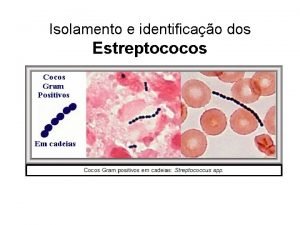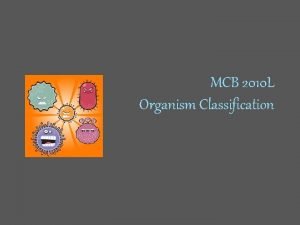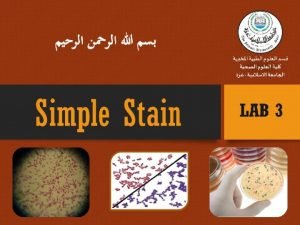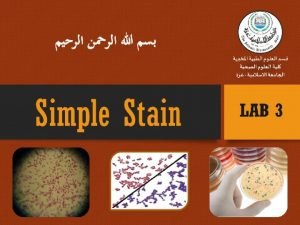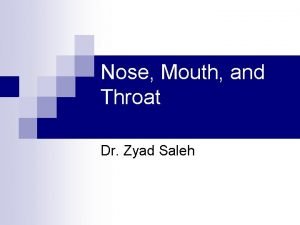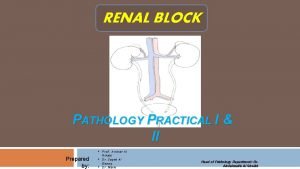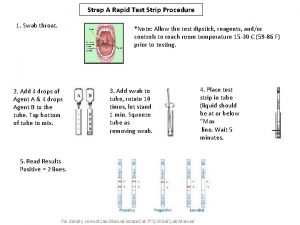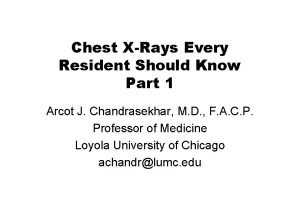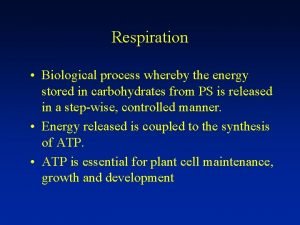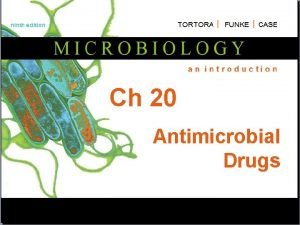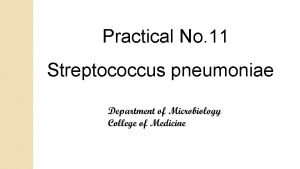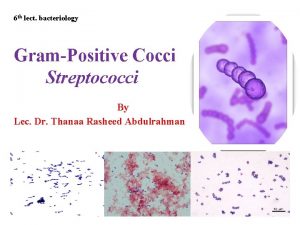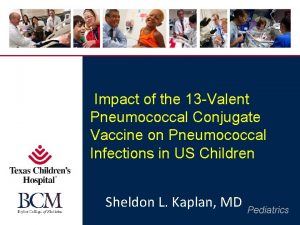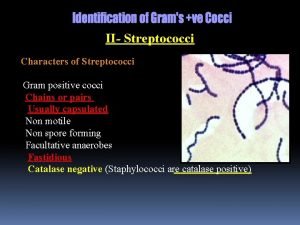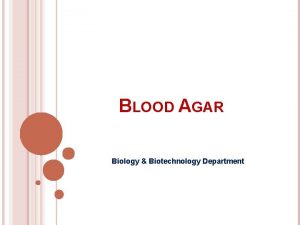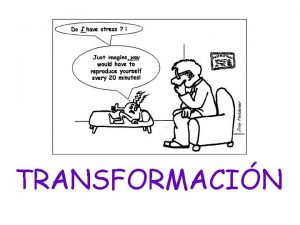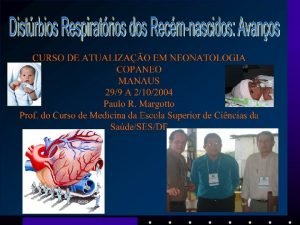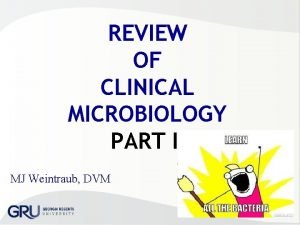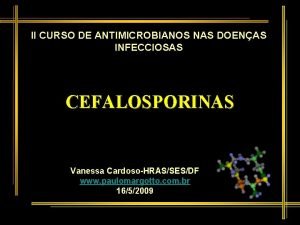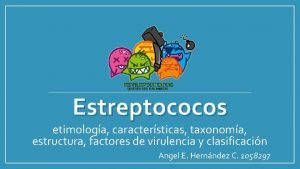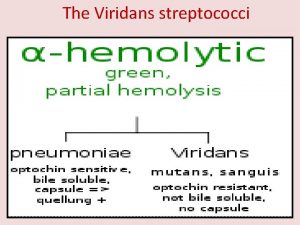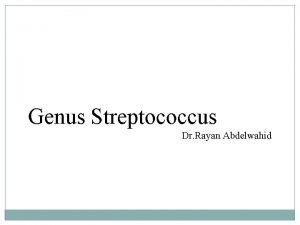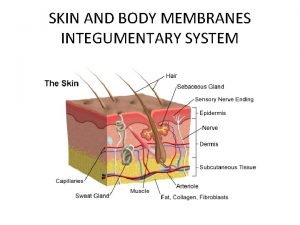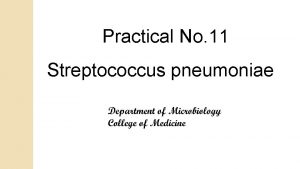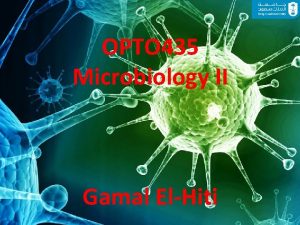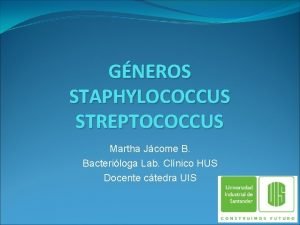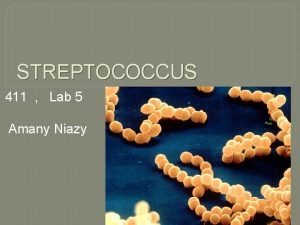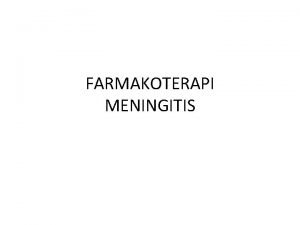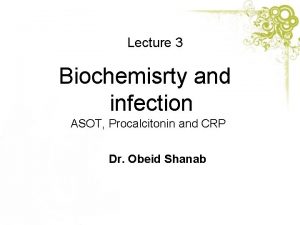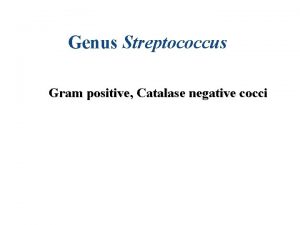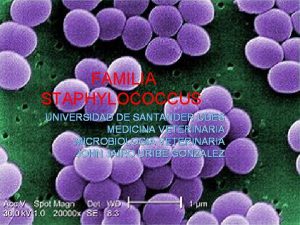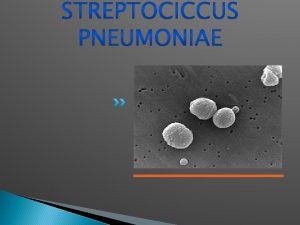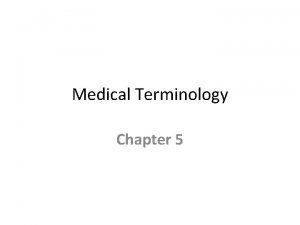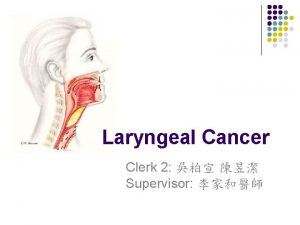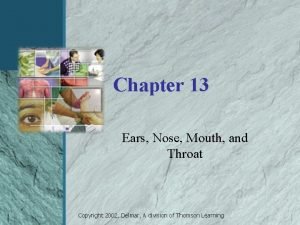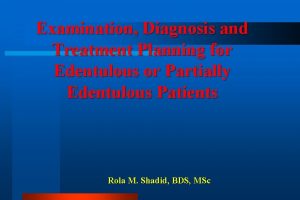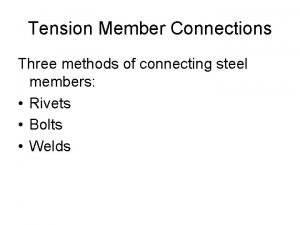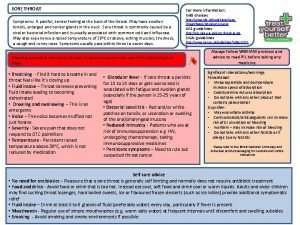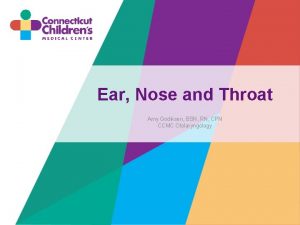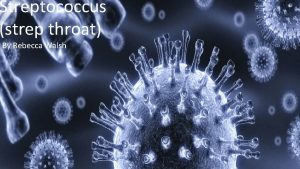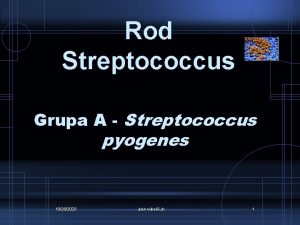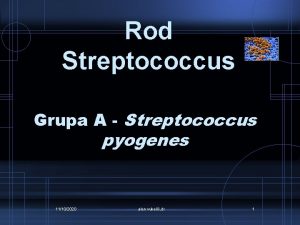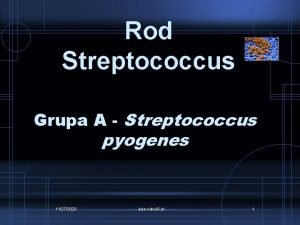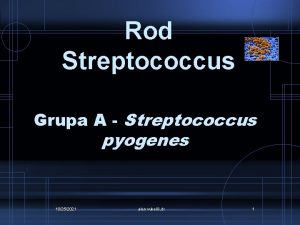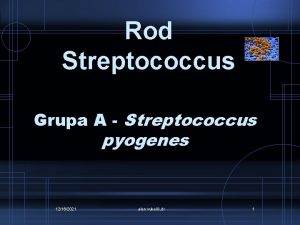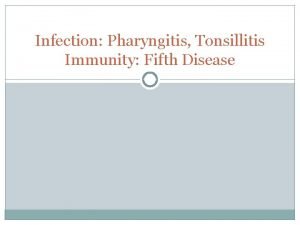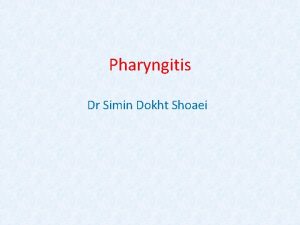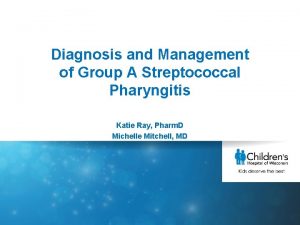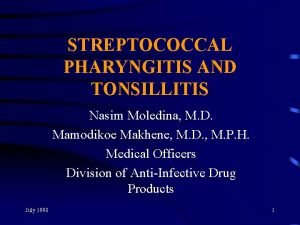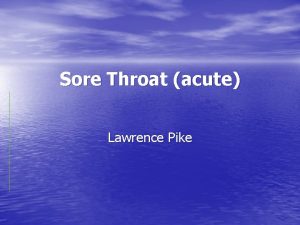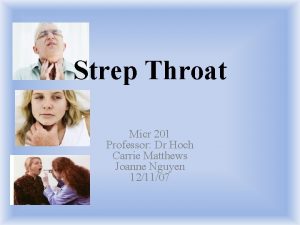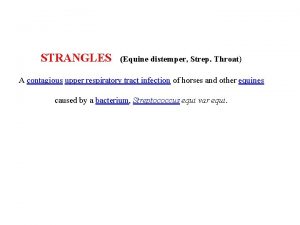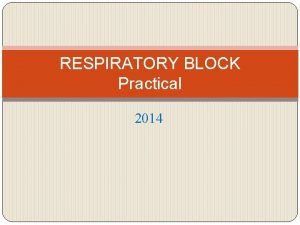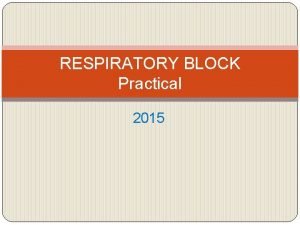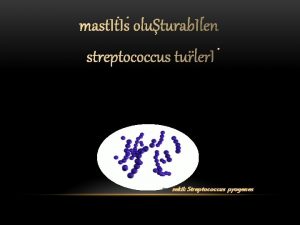Streptococcal pharyngitis Strep throat Streptococcus pyogenes Resistant to
















































































- Slides: 80








Streptococcal pharyngitis (Strep throat) • Streptococcus pyogenes • Resistant to phagocytosis • Streptokinases lyse clots • Streptolysins are cytotoxic • Diagnosis by indirect agglutination Figure 24. 3


Group A Beta Hemolytic Streptococcus

BETA HEMOLYSIS


Streptococcal Cervical Adenitis

Scarlet Fever (Οστρακιά) • Streptococcus pyogenes • Pharyngitis • Erythrogenic toxin produced by lysogenized S. pyogenes Figure 24. 4

DISEASES • Impetigo • Erysipelas

DISEASES cont. • Erysipelas • Tonsillitis

DISEASES cont. • Scarlet Fever • Toxic Shock

Diphtheria • Corynebacterium diphtheriae: Gram-positive rod • Diphtheria membrane of fibrin, dead tissue, and bacteria • Diphtheria toxin produced by lysogenized C. diphtheriae • Prevented by DTa. P and Td vaccine (Diphtheria toxoid) • Cutaneous diphtheria: Infected skin wound leads to slow healing ulcer

I. Organism -G+, club shaped, pleomorphic, aerobic rod

I. Organism -G+, club shaped, pleomorphic, aerobic rod -metachromatic polyphosphate granules

I. Organism -G+, club shaped, pleomorphic, aerobic rod -metachromatic polyphosphate granules -reduce potassium tellurite to tellurium metal - black ppt. on tellurite blood agar

I. Organism -G+, club shaped, pleomorphic, aerobic rod -metachromatic polyphosphate granules -reduce potassium tellurite to tellurium metal - black ppt. on tellurite blood agar -subtypes gravis, intermedius, mitis: severity of infection differs depending on growth rate of subtype

II. Clinical -usually presents as throat infection w/ sore throat, fever, sometimes swollen lymph glands -”pseudomembrane” forms at back of throat - may obstruct airway (“la garottilla”)


Pseudomembrane in Diptheria


Anatomy of the Ear

Anatomy of the Ear 1 Tympanic Membrane 2 Maleus Incus Stapes 3 Semicircular canals 4 Cochlea 5 Cochlear Nerve 6 Oval Window 7 Eustachian Tube 8 Orifice 9 Round Window 10 Middle Ear Cavity

Ear infections tympanic membrane Otitis externa Exogenous organisms via external auditory canal Otitis media Endogenous organisms via eustachian tube

Otitis Media • Epidemiology and Pathophysiology: • age - almost all children have one or more episodes before age 6 • about 10% of children develop OM by age 3 months • peak incidence between ages 6 and 15 months

Otitis Media • Etiology: • abnormal function of the eustachian tube

Otitis Media • Microbiology (AOM) • Streptococcus pneumoniae 35% • Haemophilus Influenzae 23% • Moraxella catarrhalis 14% • Alpha-hemolytic streptlococci 3% • GAB-hemolytic streptococci 3% • Staphylococcus aureus 1% • Psuedomonas aeruginosa 1% • Treated with broad-spectrum antibiotics • Incidence of S. pneumoniae reduced by vaccine

Otits Media • Microbiology (COM) • Haemophilus influenzae 15% • Moraxella catarrhalis 10% • Streptococcus pneumoniae 7% • Alpha-hemolytic streptococci 3% • Staphylococcus aureus 3% • Pseudomonas artuginosa 2% • GAB hemolytic streptococci 1%

Otitis Media • Inflamation of the middle ear • Acute Otitis Media (AOM) rapid onset of redness and bulging of the tympanic membrane, decreased mobility, pain, perforation with otorrhea

Otitis Media Figure 25. 7

AOE: Mild to Moderate Stage • Progressive infection • Symptoms • Pain • Increased pruritus • Signs • Erythema • Increasing edema • Canal debris, discharge

AOE: Severe Stage • Severe pain, worse with ear movement • Signs • Lumen obliteration • Purulent otorrhea • Involvement of periauricular soft tissue

Otitis Externa

COE: Signs • Asteatosis • Dry, flaky skin • Hypertrophied skin • Mucopurulent otorrhea (occasional)

Otomycosis: Signs • Canal erythema • Mild edema • White, gray or black fungal debris

Otomycosis

Herpes Zoster Oticus: Symptoms • Early: burning pain in one ear, headache, malaise and fever • Late (3 to 7 days): vesicles, facial paralysis

Erysipelas • Acute superficial cellulitis • Group A, beta hemolytic streptococci • Skin: bright red; welldemarcated, advancing margin • Rapid treatment with oral or IV antibiotics if insufficient response

Otitis externa • Organisms - Pseudomonas aeruginosa - Staphylococcus aureus - Aspergillus spp. • Treatment - oral antibiotics – NO! - topical broad spectrum (thick drops or wicks) - cotricosteroids • Prevention - avoid predisposing events. ( post swim drops, blue tack, ear “ NO GO” zone)

Sinusitis • 32 million cases annually in U. S. • 0. 5 -0. 2% of colds are complicated by sinusitis • Most acute sinusitis occurs from viral and bacterial co-infection

Sinusitis

Sinusitis

Sinusitis • Major symptoms • Facial Pain* • Nasal Obstruction • Nasal Discharge • Postnasal Drainage • Hyposmia • Fever *Location = diagnosis • Minor Symptoms • Headache • Halitosis • Fatigue • Oral Pain • Cough • Ear pain, pressure, fullness

Sinusitis • Microbiology • S. pneumoniae and H. influenzae cause 70% of sinusitis • Anaerobes, S. aureus and M. catarrhalis cause most of remaining 30%

Common cold • Rhinoviruses (50%) • Coronaviruses (15 -20%) • Rhinoviruses attached to ICAN-1 on nasal mucosa

Microbial Diseases of the Lower Respiratory System • Bacteria, viruses, & fungi cause: • Bronchitis • Bronchiolitis • Pneumonia

Lower Respiratory System • The ciliary escalator keeps the lower respiratory system sterile. Figure 24. 2

Pertussis (Whooping Cough) • Bordetella pertussis: Gram-negative coccobacillus • Capsule • Tracheal cytotoxin of cell wall damaged ciliated cells • Pertussis toxin • Prevented by DTa. P vaccine (acellular Pertussis cell fragments) Figure 24. 8

Pertussis (Whooping Cough) • Stage 1: Catarrhal stage, like common cold • Stage 2: Paroxysmal stage: Violent coughing sieges • Stage 3: Convalescence stage

Tuberculosis • Mycobacterium tuberculosis: Acid-fast rod. Transmitted from human to human • M. bovis: <1% U. S. cases, not transmitted from human to human • M. avium-intracellulare complex infects people with late stage HIV infection Figure 24. 9

Tuberculosis Figure 24. 10. 1

Tuberculosis Figure 24. 10. 2

Tuberculosis Figure 24. 10. 3

Tuberculosis • Treatment of Tuberculosis: Prolonged treatment with multiple antibiotics • Vaccines: BCG, live, avirulent M. bovis. Not widely used in U. S.

Tuberculosis • Diagnosis: Tuberculin skin test screening • + = current or previous infection • Followed by X-ray or CT, acid-fast staining of sputum, culturing bacteria Figure 24. 11

Pneumomoccal Pneumonia • Streptococcus pneumoniae: Gram-positive encapsulated diplococci • Diagnosis by culturing bacteria • Penicillin is drug of choice Figure 24. 13

Pneumomoccal Pneumonia

Haemophilus influenzae Pneumonia • Gram-negative coccobacillus • Alcoholism, poor nutrition, cancer, or diabetes are predisposing factors • Second-generation cephalosporins

Mycoplasmal Pneumonia • Mycoplasma pneumoniae: pleomorphic, wallless bacteria • Also called primary atypical pneumonia and walking pneumonia • Common in children and young adults • Diagnosis by PCR or by Ig. M antibodies Figure 24. 14

Mycoplasmal Pneumonia Figure 11. 19 a, b

Legionellosis • Legionella pneumophila: Gram-negative rod • L. pneumophila is found in water • Transmitted by inhaling aerosols, not transmitted from human to human • Diagnosis: culturing bacteria • Treatment: Erythromycin

Psittacosis (Ornithosis) • Chlamydia psittaci: gram-negative intracellular bacterium • Transmitted by elementary bodies from bird dropping to humans • Reorganizes into reticulate body after being phagocytized • Diagnosis: culturing bacteria in eggs or cell culture • Treatment: Tetracycline

Chlamydial Pneumonia • Chlamydia pneumoniae • Transmitted from human to human • Diagnosis by FA test • Treatment: Tetracycline

Mycoplasmal pneumonia • Mycoplasma pneumoniae: pleomorphic, wall-less bacteria • Also called primary atypical pneumonia and walking pneumonia • Common in children and young adults • Diagnosis by PCR or by Ig. M antibodies

Q fever Figure 24. 15

Viral Pneumonia • Viral pneumonia as a complication of influenza, measles, chickenpox • Viral etiology suspected if no cause determined • Respiratory Syncytial Virus (RSV) • Common in infants; 4500 deaths annually • Causes cell fusion (syncytium) in cell culture • Symptoms: coughing • Diagnosis by serologic test for viruses and antibodies • Treatment: Ribavirin

Influenza • Chills, fever, headache, muscle aches (no intestinal symptoms) • 1% mortality due to secondary bacterial infections • Treatment: Amantadine • Vaccine for high-risk individuals

Influenza • Hemagglutinin (H) spikes used for attachment to host cells • Neuraminidase (N) spikes used to release virus from cell

Influenza Figure 24. 16

Influenza • Antigenic shift • Changes in H and N spikes • Probably due to genetic recombination between different strains infecting the same cell • Antigenic drift • Mutations in genes encoding H or N spikes • May involve only 1 amino acid • Allows virus to avoid mucosal Ig. A antibodies

Influenza serotypes • A: causes most epidemics, H 3 N 2, H 1 N 1, H 2 N 2 • B: moderate, local outbreaks • C: mild disease

Histoplasmosis • Histoplasma capsulatum, dimorphic fungus (a) 37˚ (a) >35˚ Figure 24. 17

Pneumocystis Pneumonia • Pneumocystis jiroveci (P. carinii) found in healthy human lungs • Pneumonia occurs in newly infected infants & immunosuppressed individuals • Treatment: Timethoprimsulfamethoxazole Figure 24. 22

Blastomycosis • Blastomyces dermatitidis, dimorphic fungus • Found in soil • Can cause extensive tissue destruction • Treatment: amphotericin B

Opportunistic fungi involved in respiratory disease: • Aspergillus • Rhizopus • Mucor rouxii Figure 12. 2 b, 12. 4
 Streptococcus pyogenes meio de cultura
Streptococcus pyogenes meio de cultura Saccharomyces domain
Saccharomyces domain Streptococcus pyogenes
Streptococcus pyogenes Asm microbelibrary.org
Asm microbelibrary.org Streptococcus pyogenes
Streptococcus pyogenes Micrococcaceae staphylococcus
Micrococcaceae staphylococcus How long does strep throat last
How long does strep throat last Pathology
Pathology Quickvue rapid strep test instructions
Quickvue rapid strep test instructions Derin boyun fasyaları
Derin boyun fasyaları Strep a
Strep a Strep pneumonia
Strep pneumonia Resistant materials tools
Resistant materials tools Arc duct switchgear
Arc duct switchgear Tamper evident packaging examples
Tamper evident packaging examples Hashinny
Hashinny Savage syndrome
Savage syndrome Seismic design category
Seismic design category Packaging
Packaging Collision resistant hash function
Collision resistant hash function Earthquake resistant
Earthquake resistant Spill resistant vacuum breaker
Spill resistant vacuum breaker Design of seismic-resistant steel building structures
Design of seismic-resistant steel building structures Fire resistant cable thai yazaki
Fire resistant cable thai yazaki Rodent resistant fiber optic cable
Rodent resistant fiber optic cable Puncture resistant container
Puncture resistant container Cyanide-resistant respiration slideshare
Cyanide-resistant respiration slideshare Glycopeptide
Glycopeptide Flame resistant lab coat amazon
Flame resistant lab coat amazon Kyloc usmc
Kyloc usmc Inulin fermentation test streptococcus pneumoniae
Inulin fermentation test streptococcus pneumoniae Asm microbelibrary
Asm microbelibrary Lancefield group
Lancefield group Pediatr infect dis j
Pediatr infect dis j Streptococcus agalactiae test
Streptococcus agalactiae test Gram positive cocci in urethral discharge
Gram positive cocci in urethral discharge Streptococcus pneumoniae alpha or beta hemolysis
Streptococcus pneumoniae alpha or beta hemolysis Griffith streptococcus pneumoniae
Griffith streptococcus pneumoniae Streptococcus
Streptococcus Kvlb agar
Kvlb agar Group d streptococci
Group d streptococci Streptococcus
Streptococcus Haemophilus influenzae septic arthritis
Haemophilus influenzae septic arthritis Taxonoma
Taxonoma Streptococcus pneumoniae quellung reaction
Streptococcus pneumoniae quellung reaction Classification of streptococcus
Classification of streptococcus Streptococcus aureus
Streptococcus aureus Korarchaeotes
Korarchaeotes Streptococcus pneumoniae csf
Streptococcus pneumoniae csf Streptococcus
Streptococcus Clasificacion de rebeca lancefield
Clasificacion de rebeca lancefield Streptococcus genus
Streptococcus genus Streptococcus torok
Streptococcus torok What does bile look like
What does bile look like Acyclovir adalah
Acyclovir adalah Streptococcus aureus
Streptococcus aureus Streptococcus pneumoniae microscope
Streptococcus pneumoniae microscope Viral
Viral Streptococcus gram negative
Streptococcus gram negative Streptococcus intermedius
Streptococcus intermedius Microorganismo
Microorganismo Chapter 5 medical terminology quiz
Chapter 5 medical terminology quiz Weld positions
Weld positions Npm throat
Npm throat Images of spleen
Images of spleen Rigging tagline diameter
Rigging tagline diameter The monophasic liquids can be given for
The monophasic liquids can be given for Dextr prefix
Dextr prefix Anatomy of throat
Anatomy of throat Throat assessment normal findings
Throat assessment normal findings Smile line in orthodontics
Smile line in orthodontics Weld throat thickness
Weld throat thickness Nhs sore throat
Nhs sore throat You call me misbeliever, cut-throat dog analysis
You call me misbeliever, cut-throat dog analysis Putrid throat disease poldark
Putrid throat disease poldark Nasogastric definition
Nasogastric definition How the tiger got his stripes worksheet
How the tiger got his stripes worksheet Ukuran leher las (throat) pada sambungan sudut (t) adalah
Ukuran leher las (throat) pada sambungan sudut (t) adalah Sima feels fine but she has a sore throat
Sima feels fine but she has a sore throat Ccmc ear nose and throat
Ccmc ear nose and throat How the whale got his throat answers
How the whale got his throat answers
